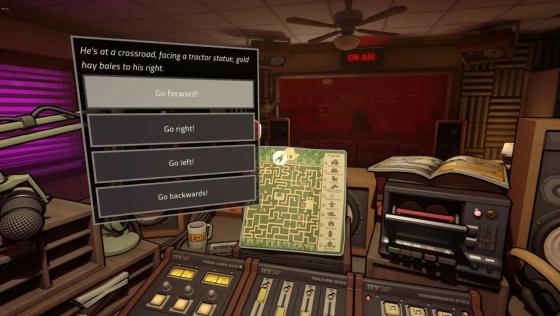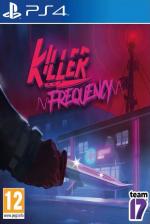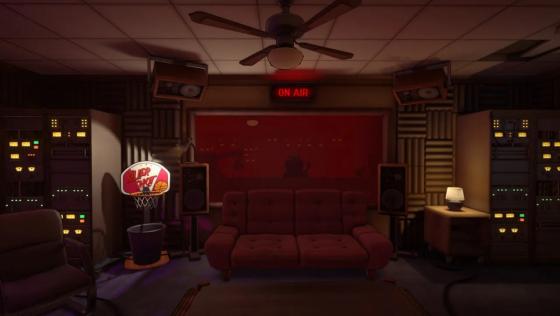
Everygamegoing
 21st January 2024
21st January 2024
Killer Frequency
Every good novelist knows that if you want to hook your reader, you should keep your narrative simple and your characters memorable. You should also never - I repeat, never - introduce a character right at the very end of your novel. That serial killer who whips off the mask in the final scene and introduces himself as someone who's never been mentioned up to that point leaves your reader feeling cheated, and wishing they hadn't read the bloody book in the first place.
Killer Frequency is a very convoluted piece of serial killer fiction/nonsense that reminded me of this salient advice. While I'm not going to give away too many spoilers in this review, the denouement - such as it is - was more or less incomprehensible. Still, you may not actually care too much, as there are a few good (well, interesting at least) puzzles to solve within it.
Anyway, before I get ahead of myself, let me introduce the premise. You are Forrest, a DJ at an all-night radio station in a small town called Gallows Creek. Your assistant, Peggy, sits in the room next door manning the phones. You can see her silhouette and hear her dulcet tones in your earphones, but you can't actually get to her or see her properly. It's a slow night in radioland until the local constabulary call in to tell you the Sheriff's been stabbed, the phone lines connecting Gallows Creek to the rest of the world have been cut, and there's a serial killer roaming the streets called The Whistling Man. With the police station out of action, the police are helpfully redirecting all 911 (for 'tis set in America) to your radio station whilst they hi-tail it to a neighbouring town to bring in backup units.

This leaves you in the strange position of having to do all the usual tasks of your average disc-jockey - play records, liaise with Peggy, take phone calls from listeners and... stop the Whistling Man from killing people! You're almost entirely confined to your DJ booth too, making at least the first three hours of Killer Frequency feel rather like an Escape Room. People call in with various problems - like the first caller who is hiding in her car and needs advice on how to hotwire it. It's your task to work out what to tell them, and you do this usually by seeking out an object, such as a guide to hotwiring cars, and then choosing one of three or four pre-rendered speech bubbles to either save the unfortunate victim... or ensure their demise. At least one of the puzzles needs a piece of paper and a pen too.
Whether or not the premise appeals to you or not, there's a lot to criticize about Killer Frequency. The most obvious is the finicky controls. A crosshair in the very middle of the screen needs to be almost perfectly aligned with the buttons on your turntable for them to work properly. This is also true for the manipulation of any objects you need. You find yourself often needing to crouch, stand up, ease one thumbstick left and right, and another up and down, just going oh-so-too-far past where you want the crosshair to be. You waste a lot of time trying to position your 'fingers' in this sort of way and there's one particular scene where you have to operate a floppy disc drive and eject and insert six different discs which is totally maddening.
By the same token, there's also the abject mundanity of constantly reaching for a new vinyl record from the pile on the left, placing it carefully on the turntable, and pressing the Play button only to be told, a few seconds later, that there's a call coming in. You then need to tediously press Stop, rotate to your left again and touch the appropriate 'line' button to start the conversation with a new character.

I suppose if you consider Killer Frequency as a sort of serial-killer walking simulator, this slow, methodical pace won't bother you. But, personally, I found it pretty tiresome.
Whilst we're on the subject (I did tell you there's a lot to criticize!), another irritant is the Escape Room style instructions that Peggy relays to you. The game has a sort of episodic nature which breaks down into you, as Forrest, needing to do something to keep it moving. But, unlike an Escape Room, where you might get a number of less and less obtuse clues if you're struggling to work out what it is you're supposed to do, Peggy just repeats the same instructions over and over. On at least two occasions, I wasn't sure where I was meant to go, and why I had to do something but I just set off randomly hoping I would work it out en route. On another occasion, I just couldn't find whatever object I was meant to, and the game suggested I "try to wing it". I was so bored by that point that I agreed, and that interaction went about as well as you'd expect, ending with the caller agonizingly screaming down the phone. Sadly there was no option for Forrest to do the same.
Finally, we come to the biggest problem with Killer Frequency. There are just too many characters, and too many relationships, for the player to keep them all in his brain. There's nothing visual to go on. If you're playing one of the Supermassive Games' "teens in trouble" slasher movie-style games, you can obviously see the characters interacting with each other, and you sort of intuitively glean who's friends with who, who's related to who, etc. This is practically impossible with a bunch of discordant voices on a radio show, especially when they're talking about characters that not only live in the town now, but who also lived there thirty years previously!

It's all a tiny bit... silly too, isn't it? I mean, many of these characters ring 911 because they need emergency help and the first thing they hear is "Hello, this is Forrest Nash. You're on the air." But they all continue the conversation? Hmmm.
Right, enough moaning. Killer Frequency has some surprises up its sleeve which I really enjoyed. Firstly, I was very thankful for the way it 'opened up' as the game progressed. Being confined to the booth for so long left me wondering whether the booth was all the game had - so as I was able to move further and further into the adjoining offices, staff quarters, basement, cupboards and even outside of the building, I felt a lot of my initial boredom dissipating.
I also think it all looks very appealing. It has that sort of Eighties' feel to it, with vinyl records to play, dated technology on display throughout the radio station, no Internet, a small community of people ringing their local radio station on a night, and even a few bad jokes littering the 'action'. The voice acting is superb too, but then it really had to be when it needs to convey the entire story (You will spend many many hours just staring at Peggy's silhouette and randomly fiddling with buttons while you listen to the characters).
Unfortunately, on balance, well it doesn't balance to the extent that I can give Killer Frequency a recommendation. Really it comes down to the perplexing narrative more than anything else. The game left me feeling stupid for not being able to understand more than about 40% of what was going on, and having to solve every single problem by choosing one of a selection of responses made me feel like I was just going through the motions than actually using my brain in the way the game obviously intended. The game also crashed on me once, and seemed to spend an age loading each time I broke off from it for a while.
I haven't really played anything else quite like Killer Frequency though, so it may well find its share of fans. I think, ultimately, Team 17, have just tried to be far too clever with it. A shorter game (which let you out of the booth sooner), a greatly reduced cast of characters and a much less convoluted plot would probably have worked much better. And it needed a completely different ending - one with an unexpected twist in the tale - to achieve greatness.
As it stands, a mediocre experience and one that I won't be going back to repeat.
Scores
PlayStation 4 Version| Graphics | 75% |
| Sound | 94% |
| Playability | 31% |
| Lastability | 43% |
| Overall | 60% |













